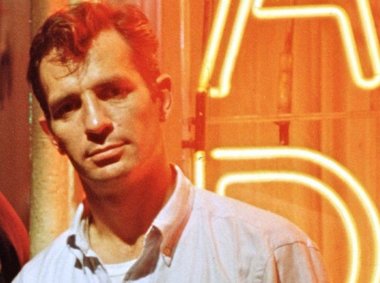October 21st in NYC History - Electric Light Whitey Wright's Guggenheim Bebop Jazz Poet improvisers
Posted: Oct 20, 2012 | 9:31 PM
1845: In four innings New York beats Brooklyn 24-4 in Hoboken's Elysian Fields. Afterwards they have dinner. How do we know? This game was the first documented article and boxscore of a baseball game, appearing in The New York Morning News
1879: Thomas Edison invented the electric light at his Menlo Park, N.J. laboratory.
1910: The New York Giants beat the New York Highlanders (Yankees) 6-3, winning the World Series 4-1-2.
1917, Dizzy Gillespie, the American jazz trumpeter, composer, and bandleader, was born. He was a kind and generous man with an easy laugh who did a great deal for New York City. I saw him perform at the North Cove Marina at the World Financial Center and at the Delacourte Theater. He died in 1993.
1924: Joyce Randolph, Actress made famous in "The Honeymooners"), born.
1927: Groundbreaking begins for the George Washington Bridge in New York and New Jersey. It will open to traffic four years later.
1928: Astoria's pride, Baseball Hall of Famer "Whitey" Ford born. A great pitcher who spent his entire 16-year career with the New York Yankees.
1942: Judy Sheindlin, "Judge Judy" born. We see where she went to Law School on Downtown and World Trade Center tours.
1956: NY Giants football moved from its Polo Grounds home to Yankee Stadium, beating Pittsburgh 38-10 at their first home game there.
The Guggenheim Museum:
1959: Frank Lloyd Wright's unique building, the Guggenheim Museum opens on 5th Avenue's Museum Mile. It took over ten years to build, relying on new technologies involving reinforced concrete. It has undergone at least two major renovations in 50 years. Thousands of people lined up to see the spectacle, home to a great modern art collection.
From the beginning there has been a tension between the art of the architecture and the art it contains and displays. In my opinion, the playful building overshadows the art, making concrete, literally, the Beaux Arts tradition of architecture being the primary art.
Experiencing the art on a slant in a spiral suggests that the museum is a machine for processing the architecture and the art, that we are ball bearings traveling along a slot.
The building is also biomorphic in the midst of Manhattan's rigorous grid and boxy beige buildings.
It attracts nearly 1 million visitors annually to it quarter mile track among 500,000 square feet (50,000 meters2), approximately 5 Walmarts.
Jack Kerouac:

1969: Writer Jack Kerouac died at 47 years old. Pretty much debauched, bitter and ill from alcohol, the great Beat poet and author launched a nation of empty-feeling youth on a search for thrills and the now, yet felt passed by by the hippies that he inspired and did not like. His friends Alan Ginsberg, and his inspiration for 1957's On the Road, Neal Cassady, made that transition of eras, becoming avatars of the hippies. Kerouac, of French Canadian ancestry, came to Columbia from Massachusetts on a football scholarship to be a Quarterback. In college he befriended Ginsberg and Carr, and they fell in with the Times Square drifters, drug addicts and hustlers that inspired their work based on spontaneity, real life experiences, intensity, including those on the peripheries of society. He loved the bebop Jazz expressions and improvisations that inspired his poetry, and he sought enlightenment and peace from Buddhism. Still, he could not shake what shook him.
1960: John F. Kennedy and Richard Nixon's fourth and final presidential debate was televised from New York City.
1976: Willis Reed's number 19 is the first Knick's number retired in the rafters of Madison Square Garden.
1988: Deposed Philippine Dictators President Ferdinand Marcos and his wife, Imelda, the shoe queen, are indicted in New York for fraud and racketeering.
1980: The odious TV personality Kim Kardashian was born to OJ Simpson's lawyer.